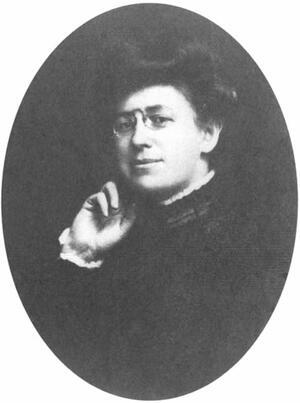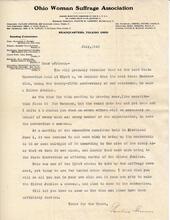Pauline Perlmutter Steinem
A suffragist who encouraged newly enfranchised women to go to the polls together to avoid harassment, Pauline Perlmutter Steinem was the first woman elected to the Toledo Board of Education. Her legacy of social activism can be seen in her granddaughter, Gloria Steinem.
Institution: The Jacob Rader Marcus Center of the American Jewish Archives, Cincinnati, OH, www.americanjewisharchives.org and the Toledo-Lucas County Public Library
Pauline Perlmutter Steinem, grandmother of Gloria Steinem, was born in Germany to Reform Jewish parents originally from Russia. Steinem was educated and earned a teacher’s diploma. In 1884, she married Edgar Steinem, a German immigrant to Ohio, and moved to Ohio. Pauline became an ardent activist and served as president of the Toledo section of the National Council of Jewish Women, national chair of the Sabbath School Committee, as well as other organizations. She advocated for improvements to education and was an active suffragist, traveling to Washington, D.C. to march and protest. As a result of her inspirational leadership, she became one of the few women listed in Who’s Who in America. Additionally, just before World War II began, she helped send as many European relatives as she could to Israel to escape the Nazis.
Early Life
Pauline Perlmutter Steinem was born on August 4, 1866, to Bertha (Slisower), a homemaker, and Hayman Perlmutter, a cantor, just after the couple left Russia to live in Germany. According to family lore that was passed down to me as her granddaughter, they left as part of the Reform wave of Judaism, and also because Hayman Perlmutter wanted to write operas, a secular interest the Orthodoxy had opposed.
Thinking about this grandmother who died when I was five years old, I imagine that the liberal spirit of Reform Judaism helped her achieve a higher education than was usual for a Jewish female. At a time when young women were told that intellectual activity was a danger to their reproductive systems, my grandmother graduated from the teachers’ seminary at Memmingen, Bavaria, with a teacher’s diploma. Perhaps this spirit also opened the way to her later work as a suffragist—after all, the Reform Movement had broken the prohibition against women and men worshiping together—and to her discovery of Theosophy, a movement that gave an Eastern spiritual base to Reform Judaism’s belief in social justice and the moral life. Together with her dedication to her family and the Jewish community, these remained Steinem’s lifetime interests: education, universal adult suffrage, and Theosophy.
Marriage and Family
From samplers of fine embroidery that were passed down to me, however, I also know she learned the traditional arts. At age seventeen or eighteen she was a new graduate, when Joseph Steinem returned to his native Germany to find a suitable wife. While waiting in the family parlor to meet her older sister, this man in his early thirties, a hardworking immigrant in Toledo, Ohio, saw and fell in love with Pauline Perlmutter. In order to secure her hand, he made two promises: first, that he would send her home every few years to visit her family, and second, that he would sell the small brewery that, together with a few rental properties, was the source of his livelihood. Though her family made the first request, my grandmother herself insisted on the second. She was so opposed to alcohol that only paste vanilla went into her cooking. As a strict vegetarian, she kept both customs, even though she cooked meat for her sons and tolerated wine for others.
They married in 1884. After their first son, Edgar, was born in Germany, they returned to Ohio when Steinem was age nineteen. Three more sons were born in Toledo: Jesse, Clarence, and Leo, who was the youngest and my father.
Jewish Activism, Educational Innovation, and Women's Suffrage
By all historical evidence, Steinem was a remarkable activist. Over the years, she served as president of the Toledo section of the National Council of Jewish Women, national chair of the Sabbath School Committee, president of the Hebrew Associated Charities and Loan Association, president of the Federation of Women’s Societies, and on the Ohio Board of Charities.
Given her abiding interest in education, she also helped to develop the Ohio Juvenile Court, was the first woman elected to the Toledo Board of Education, and founded Macomber Vocational High School, the first public school for vocational education. (According to some, the choice between naming the school after her or after Macomber, its financial benefactor, was made by the flip of a coin, but according to others, by anti-Semitism.) She was also an active suffragist, and in the early years of the twentieth century, she became one of the few women listed in Who’s Who in America.
In the years after my grandmother’s death at age seventy-three in January of 1940, I always understood that the woman I had known as “Mama Einie” was admirable. My mother’s stories praised her community leadership, her perfect housekeeping, her unaccented English and excellent writing style (which she learned within a few years of arriving in America), and, most of all, her deep love of Theosophy—an interest my mother shared. Though marriage between my middle-class Jewish father and working-class Protestant mother had been opposed by both families, my mother and my mother-in-law gradually grew to love each other. I knew that the Bible passage, “Whither thou goest, I will go...thy people shall be my people,” had been said by one woman to another, because my mother said it to her mother-in-law, just as the biblical Ruth had said it to Naomi.
Active statewide in the Ohio Woman Suffrage Association, Steinem also headed the educational committee of the National Woman Suffrage Association, traveled abroad in 1908 as one of two U.S. delegates to the International Council of Women, and marched and testified in Washington, D.C. (She wrote a letter of complaint to her senator about the absence of police protection for marchers in 1913.) My family had not concealed these events, but they saw the ways my grandmother served her family and community as more praiseworthy than the ways she tried to transform them. For instance, I knew she had been elected to the school board, but not that she was the first woman elected to any public office in Toledo—perhaps the first in Ohio—or that she was elected on a coalition ticket with the socialists and the anarchists.
There are many stories I cherish. Here are two I’ve learned only in recent years.
After my grandfather died—either from pneumonia or despair at losing most of his money in the crash of 1929—my grandmother’s income was about $500 a month. Before World War II, when ransoming Jews from Nazi Germany was still possible, the price of sending one person to Israel was also $500. Despite opposition from some of her family at spending her money this way—and despite her position as a universalist, not a Zionist—she sent as many relatives as she could.
Women did not yet have the vote nationally when my grandmother ran for the board of education, and many resented the newly won right in Ohio. To frighten women out of the “unnatural” act of voting, gangs of men and boys surrounded the polls, and indulged in what we would now call sexual harassment. My grandmother won by organizing women to go to the polls—together.
It was this sense of unity—with other people and with all living things—that I find inspiring in Pauline Perlmutter Steinem.
AJYB 7 (1905–1906):105.
NYTimes, January 7, 1940, 49:3.
WWWIA 4.




